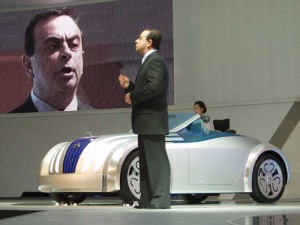Calling it the “key” to the company’s future, Nissan will invest $8 billion in an aggressive Chinese expansion plan that it hopes will help double annual sales in the booming Asian market.
Working with its local partner, the Dongfeng Group, Nissan says it will add another 30 new models to its Chinese line-up by 2015, including a new battery-electric vehicle that will be sold under the new low-priced Venucia brand.
In all, Nissan CEO Carlos Ghosn said the Japanese maker hopes to nearly double sales in China over the next four years. They hit 1.3 million last year but Nissan is targeting a figure closer to 2.3 million by 2015.
“China is key to our total growth,” the Brazilian-born executive declared during a Beijing news conference. “We used to be extremely dependent on one market – it was the U.S. market,” he added, but the company’s strategy is now to put more emphasis on China.
The Chinese market is the world’s fastest-growing, with unit sales jumping 32% last year to 18 million – which also makes it the largest national automotive market. But there have been some signs of a slow-down in recent months, in part driven by efforts to curb congestion in crowded cities like Beijing and Shanghai. The Chinese government has also eliminated several incentive programs that had been propping up demand.
Few expect the market to stumble but there are growing concerns about the level of investment going into China, virtually every major automaker now targeting the country as essential to future growth. Chinese auto industry leader GM, for example, expects to boost sales to 5 million, but Volkswagen, Ford and Toyota, among others, are also looking for bigger slices of the Chinese pie.
One reason why so many makers believe they can still gain ground is that, until now, the automotive boom – like the overall surge in China’s economy – has largely been focused along the Pacific Coast. There’s a push to expand that into western provinces and second- and third-tier cities – more than 100 of which still have populations of more than 1 million.
To take advantage of those new markets, Nissan is lifting a page from the playbook of more established competitors, such as GM, which earlier this year introduced the Baojun marque. Nissan is setting up an additional, lower-priced sales channel dubbed Venucia. The plan to offer an electric vehicle through that network is significant considering the high cost of batteries.
The Venucia brand will be headquartered in China, noted Ghosn, and will rely on an R&D staff of 3,500 – which could grow to 5,000 over the next five years.
Combining its various brands, Nissan aims to boost its current 62% market share to 10% by 2015. That would help bolster Ghosn’s six-year Power 88 plan, which targets an 8% global share.
To support its Chinese drive, the maker will open a number of new plants, starting with one in Shiyan that will begin producing commercial vehicles this year. Another, in Guangzhou, is scheduled to begin operating next year. Another new factory will go into the eastern city of Changhzhou.
But still more plants might be needed, suggested Ghosn, telling a Beijing news conference that, “I’m afraid that even with the capacity we announced today, we might be short.”
Significantly, Ghosn revealed plans to begin exporting about 40,000 Chinese-made vehicles a year to Latin America and other emerging markets. That number would double by 2015, according to the plan he announced, but exports are considered only a marginal goal because Nissan believes it will need most of its expanded capacity to simply keep up with the growth in Chinese home market demand.
While the market is putting a heavy emphasis on China it is also pressing into other potentially lucrative markets, notably Brazil, the Power 88 plan calling for the addition of a new plant there, as well. And Nissan is pushing for big growth in Russia, as well.

